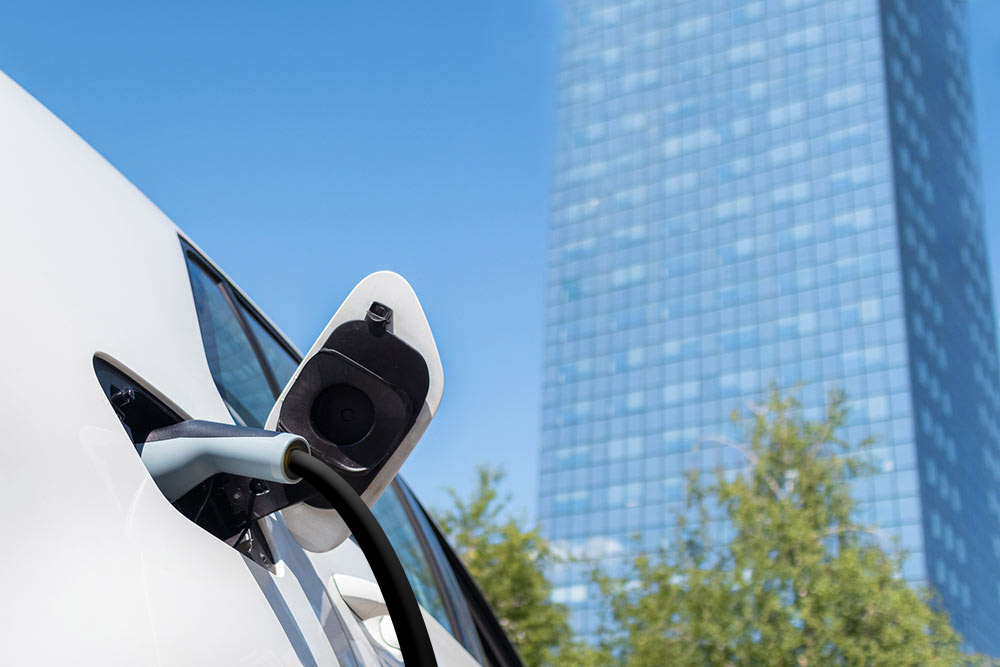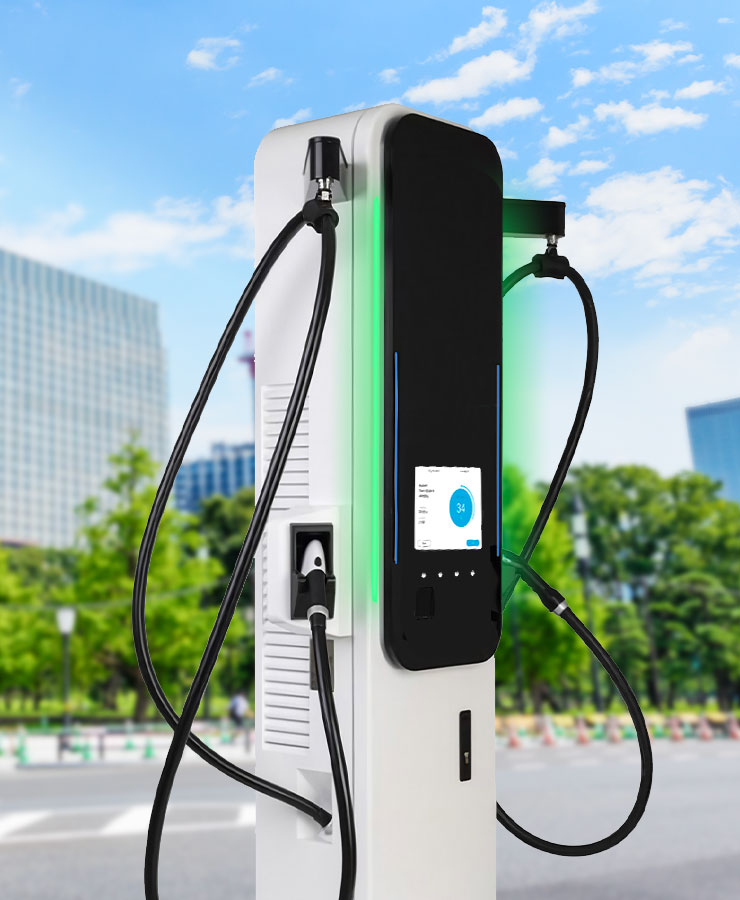
Remote, flex, hybrid or full-time in the office? The global COVID pandemic created new options for work arrangements. However, the landscape is changing as the pandemic fades, increasingly putting these arrangements in flux. Currently, the vast majority of companies, or 90%, plan to implement return-to-office (RTO) policies by the end of 2024. This RTO trend coincides with the fact that the electric vehicle (EV) market is experiencing significant growth, with 28% of prospective car buyers considering an EV purchase within the next year.
The demographics of EV ownership are particularly noteworthy in this context. Currently, 42% of EV owners are aged 30-44, a 5-percentage point increase since 2021.1 Additionally, almost half or 48%, of those ages 18 to 29 stated they would consider an EV purchase. This places a substantial portion of EV owners squarely within the prime working age group, underscoring the growing importance of workplace charging solutions.
As companies navigate the grudging reluctance of workers to comply with RTO policies and seek to attract and retain talent, the provision of workplace EV charging stations is emerging as one of the perks or amenities designed to make RTO more palatable. Offering workplace EV charging stations bridges the gap between evolving work arrangements and the rising trend of EV adoption among workers.
The growing demand for workplace EV charging
In 2023, according to CBRE Group Inc., a worldwide commercial real estate service company, workplace charging sessions grew twice as fast as new workplace charging installations. This highlights the gap between available charging and increasing driver demand. Active workplace EV charging ports increased by 22% year-over-year, while the number of unique drivers charging in workplace settings surged by 57%.2

Strategic placement of workplace EV charging stations
Given the growth in demand, many workplaces are considering adding EV charging stations. Yet it’s not a simple decision to make or implement. Why should they be installed? How many chargers and what type? Is there public funding available to support the investment?
For maximum effectiveness, workplace EV charging stations should be installed in easily accessible, high-visibility areas. Ideal locations include:
- Near building entrances or in prominent parking areas
- Close to electrical infrastructure to minimize installation costs
- In covered areas such as a parking garage or beneath solar canopies for weather protection and to leverage renewable energy sources
- Adjacent to common areas or break rooms
- Near visitor parking to accommodate clients and guests
The flexibility of Level 2 (L2) charging stations, such as BTC POWER’s L2 MaX, allows for versatile placement options. These chargers can be easily installed near office entrances, providing a convenient and visible location for employees and visitors. Alternatively, L2 EV chargers can be seamlessly integrated into existing parking structures that are already equipped with electrical infrastructure, such as parking garages or covered lots. This flexibility enhances accessibility and reduces installation costs by taking advantage of areas where electricity might already be available.
As more consumers purchase electric vehicles, businesses or building owners should plan for growth. Choose locations that allow for easy expansion as demand increases. This might mean installing conduits to additional parking spaces during initial installation.
Another consideration is traffic flow. Avoid placements that could cause congestion or impede emergency vehicle access. Companies can follow best parking lot EV charger installation practices, with more detailed information available here.
By carefully considering these factors, businesses can create an EV charging infrastructure that meets the current needs of their EV-driving employees and adapts to the growing demand for workplace charging.
Understanding workplace EV charging station options
For most workplace settings, L2 EV chargers are a practical and cost-effective choice. Operating on 240V, these chargers can typically provide about 25 miles of range per hour of charging. This means that during an 8-hour workday, an employee could potentially add 200 miles of range to their vehicle – more than enough for most daily commutes.
However, DC Fast Chargers (Level 3) are becoming increasingly popular in various workplace and commercial settings due to their ability to charge vehicles much faster and serve both employees and customers. Distribution centers with short turnaround times or businesses with diverse vehicle fleets might consider a combination of L2 and DC fast chargers, such as the Gen 4 All-in-One, to accommodate the various charging needs.
While more power-intensive and generally more complex to install and operate, DC Fast Chargers can be highly beneficial for numerous business scenarios:
- Corporate campuses: Large companies can attract and retain employees by offering fast charging options, especially for those with longer commutes.
- Retail and hospitality: Shopping centers, hotels, and restaurants can use DC fast chargers to attract customers and encourage longer stays, potentially increasing revenue.
- Transportation hubs: Airports, train stations, and bus terminals can provide quick charging options for travelers and ride-share drivers.
- Healthcare facilities: Hospitals and medical centers with 24/7 operations can benefit from fast charging options for staff and visitors.
- Educational institutions: Universities and colleges can serve both commuting students and faculty while potentially generating revenue from public use.
- Entertainment venues: Movie theaters, sports stadiums, and concert halls can offer fast charging as an additional amenity for patrons.
- Automotive businesses: Car dealerships and service centers can provide fast charging for customers and demonstrate the benefits of EVs.
- Logistics and distribution centers: Warehouses and distribution centers with electric truck fleets can minimize downtime and maintain operational efficiency. Companies that operate Class 6 or Class 7 electric trucks for deliveries or logistics will find it useful to install an EV DC fast charger in the loading dock area. Larger vehicles and batteries require more power and faster charging times than an L2 charger can supply.
Installing DC fast chargers can serve multiple purposes for businesses:
- Future-proofing: As EV adoption increases, having the most advanced infrastructure in place ensures desired charging speeds as battery technology in EVs advances.
- Revenue generation: Businesses can charge for the use of their fast chargers during off hours to travelers or local residents, creating a new income stream.
- Property value increase: EV charging infrastructure can make commercial properties more attractive to potential buyers or tenants.
- Customer attraction and retention: Offering fast charging can differentiate a business from competitors and encourage customer loyalty.
The choice between L2 and DC fast chargers depends on the specific needs of the business, the types of vehicles in use, and the desired charging speed. While L2 chargers are suitable for most office-based scenarios, commercial DC fast chargers can play a crucial role in supporting the electrification of commercial vehicle fleets and high-turnover operations.

Is a workplace EV charger a taxable benefit?
The tax implications of workplace EV charging are generally neutral for both employers and employees. As of 2024, the Internal Revenue Service (IRS) typically considers workplace EV charging as a non-taxable de minimis fringe benefit.3 This classification means that the value of the EV charge is deemed so minimal that accounting for it would be unreasonable or administratively impractical. As a result, employees do not incur additional tax liability for using workplace EV charging stations, and employers don’t receive direct tax benefits for providing this service.
While there may not be direct tax advantages, businesses might benefit from other incentives for installing EV charging stations. The National Electric Vehicle Infrastructure (NEVI) Formula Program, while primarily focused on creating a national network of commercial EV chargers along designated corridors, could potentially benefit some workplaces if they meet specific criteria and location requirements. Additionally, state and local governments may offer their own incentives or grants for businesses installing EV charging infrastructure. Companies should consult with tax professionals to understand the full range of potential benefits and implications specific to their situation and location.

Can a commercial workplace EV charging station be profitable?
Determining the profitability of installing workplace EV charging stations involves considering both direct and indirect financial benefits. While these stations may not always generate immediate revenue, they can contribute significantly to a company’s bottom line through various means.
Employee retention is a key factor, as offering EV charging can reduce turnover and the associated costs of hiring and training new staff. Additionally, workplace charging stations can enhance a company’s image, potentially attracting environmentally conscious clients and partners. This improved corporate image may lead to increased business opportunities and partnerships, indirectly boosting profitability.
Some companies are open to the idea of public accessibility to the charging stations. A tiered pricing model enables employees to receive free or discounted charging while public users pay market rates. As for security and preventing unauthorized use, many workplaces implement access controls rather than completely shutting off stations at night. This can include key card access systems or mobile apps that allow only authorized users to activate the chargers, ensuring that the benefit remains exclusive to employees or approved users while still being available 24/7.
Reasons workplace EV charging might be profitable:
- Employee retention
- Enhanced corporate image
- Potential public revenue
- Increased property value
- Tax incentives and grants
- Competitive advantage in hiring
As businesses navigate the post-pandemic landscape and the shift towards sustainable transportation, workplace EV charging stations have become a necessity. The fact that most companies plan to bring employees back to the office even as a hybrid model combines with increased EV adoption among consumers points to the wisdom of investing in EV charging availability on-site.
Companies can turn to BTC POWER for domestically manufactured and available L2 and DC fast chargers for installation on workplace premises. We’ve worked with more than one North American company for charger installations to service employees and visitors, commercial retail parking lot installations and, of course, refueling stations. Contact BTC POWER today to learn more about our EV charger options for workplace facilities and environments.
BTC POWER is the largest EV charger manufacturer in the country, providing the top commercial EV charging stations for locations including the workplace, office buildings and administration campuses.
- Finn US. “Electric Vehicle Ownership Report,” 2024.
- DC Velocity magazine. “Businesses Woo Employees with Workplace Chargers,” May 2024.
- Internal Revenue Service (IRS) website.


